Zamora (Spain)
Zamora is a city in Castile-Leon, Spain.
Understand
Zamora is a small and quiet town of 65,000 inhabitants located in the southeast of the province. The town of Zamora lies on a rocky hill in the northwest of Spain, near the frontier with Portugal and is crossed by the Douro river (río Duero).
Zamora is the city with the highest concentration of Romanesque art and architecture in Europe, and is therefore known as the city of romanesque. The 14 Romanesque churches in the old town (also has 23 temples municipality) and the Cathedral draw a lot of attention, as well as the castle surrounded by gardens (its inside can be visited), medieval ramparts, the bridge, two palaces and nine houses.
Holy Week in Zamora is very famous and attracts a large number of visitors.
The town is on the European modernist route, with 19 buildings with clear influence from Catalan modernism.
Through the province of Zamora passes the vía de la plata (silver way), a millenary Roman route that connects Seville to Gijón and also traditionally has been used as a southern route of the Way of St. James by pilgrims on their way to Santiago de Compostela. This route is becoming increasingly popular and crowded. In Zamora, lodging is offered to pilgrims in the pilgrims' hostel next to the Church of San Cipriano, for those who spend the night in the town.
Tourist offices
- turismoenzamora.es Provincial Tourism Office Zamora (Oficina de Turismo), Plaza de Viriato s/n, Zamora (In Plaza de Viriato- diagonal from the Parador de Zamora), ☎ +34 980 559 300. A wise stop before going sightseeing. Hard to miss, as it's across and diagonal from the Parador of Zamora. You can get free posters and maps of the town, province, etc as well as directions and suggestions on where to go and what to visit.
- Municipal Tourist Information Office, Arias Gonzalo Square, 6, ☎ +34 980 53 36 94, e-mail: oficinaturismo@zamora.es.
- www.truismocastillayleon.com/es/destinos Tourist Office of Castile and Leon, Príncipe de Asturias Avenue, 1, ☎ +34 980 531 845, e-mail: oficinadeturismodezamora@jcyl.es.
Get in
By car
Zamora is well connected by several new highways. It is now possible to get to/from Valladolid (and therefore Madrid), Salamanca and Benavente by highway. It is also well connected by smaller highways to other surrounding towns, villages and Portugal.
By bus
There is a Bus Station from where you can take a bus to Salamanca, Valladolid, Madrid, Barcelona, Bilbao, Sevilla and many other cities of Spain and Portugal.
By train
Zamora has a nice Train Station with two lines:
- A Coruña, Santiago de Compostela, Ourense, Zamora, Segovia, Ávila y Madrid. The train to/from Madrid is the AVE (Alta Velocidad Española) line.
- Connection Puebla de Sanabria with Valladolid. On the train ride Zamora to Puebla de Sanabria, old Train Stations and landscapes are especially beautiful.
By plane
The nearest commercial airport is Villanubla, just a few kilometres out of Valladolid, the capital of the Castile-Leon region. Valladolid lies some 90 km from Zamora (one hour and quarter by bus). This small airport is served by flights run by Iberia, Air France and Ryanair. The low-cost carriers travel to and from Barcelona, Lanzarote, London-Stansted airport, Brussels-Charleroi airport and Milan-Malpensa.
Madrid airport is relatively close to Zamora (3 hours by bus) and is much better connected to European destinations and the rest of the world.
Get around
The city is pedestrian friendly with many car free zones. Everything is accesible by foot, especially the main attractions, which are fairly close to one another. For slightly longer journeys there are two taxi companies, and several bus routes - tickets are cheap, and you can buy them directly from the driver on board or for longer stays get a travelcard from one of the branches of the bank Caja Duero. During the summer months be sure to take advantage of the Tren Turístico (Tourist train) that offers a ride all around the city and gives a great overview of history and monuments.
See
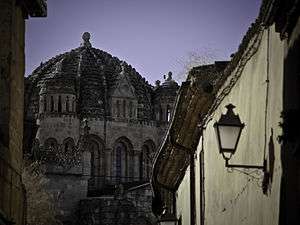
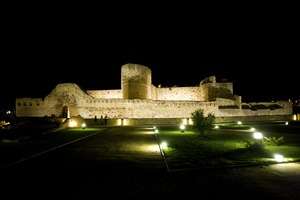
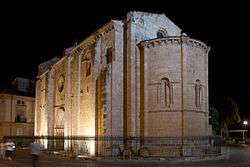
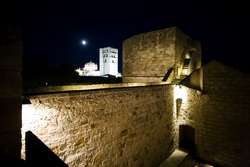
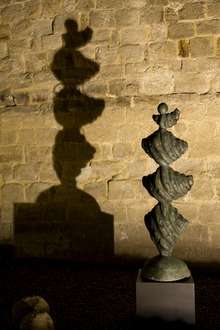
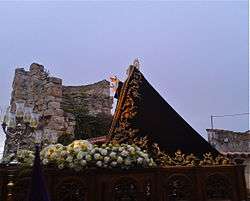
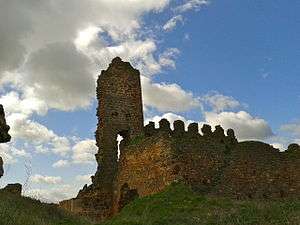
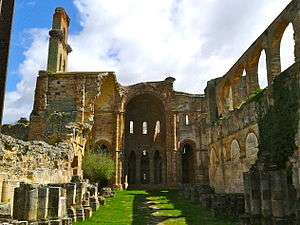
- Zamora Cathedral. Romanesque dating back to the 12th century, taking only 23 years to build.
- Medieval Castle. Built in the Middle Ages, offering magnificent views of the town, the river and surroundings.
- Medieval ramparts
- Viewpoints towards the Douro river
- Viriato Square
- Mayor Square
- Balborraz street
- Santa María Magdalena Church
- San Ildefonso Church
- San Cipriano Church
- Santa María la Nueva Church
- Santiago de los Caballeros Church (12th century carvings on the columns)
- San Juan de Puerta Nueva Church (12th century, featuring a stained glass circular window, symbol of Zamora)
- San Claudio de Olivares Church (12th century carvings on the columns)
- Momos Palace (romance building)
- Palace of Condes de Alba y Aliste
- Romance bridge
- Bridge of poets
- Riverbank path close to historical center
- Watermills “Las Aceñas de Olivares”. 10th century. Inside the three watermills is Interpretation Center of traditional industries water.
- Watermills “Las Aceñas de Cabañales”
- Pelambres Beach (riverbank in front of Cathedral)
- Thoroughfare of three trees (paseo de los tres árboles)
- Valorio forest (bosque de valorio)
Museums and cultural centers
- Ethnographic Museum of Castilla y León. Hosts an impressive and valuable collection of 10,000 pieces that reflect the enormous and varied heritage of Castilla y León tied to their traditions and customs.
- Cathedral’s Museum. Its collection of tapestries of the fifteenth and sixteenth centuries is considered one of the best in the world.
- Zamora’s Museum (Cordón Palace)
- Museum of Holy Week. Opposite the Santa María la Nueva church, devoted to the Holy Week processions which are celebrated with particular ceremony in Zamora. The museum displays a large collection of pasos, the figures which are carried in procession through the streets by various 'cofradías' or brotherhoods.
- Museum of Baltasar Lobo (a famous sculptor).
- Rei Alfonso Henriques Foundation.
- Interpretation Center of traditional industries water (Las Aceñas de Olivares).
- Interpretation Center of medieval ramparts
- Diocesan Museum at the Church of Santo Tomé.
- Principal Theatre.
Do
- Old Town, especially the whole forming Cathedral, Castle and its gardens and medieval ramparts.
- Viewpoints towards the Douro river.
- Riverbank path close to historical center. If the walk is at sunset is better to start the walk way from the "thoroughfare of three trees" (paseo de los tres árboles), you can even cross to one of the islands in the river, then pass, (if the river is not very grown up) through the eye of the roman bridge and address watermills "Aceñas de Olivares".
- Cross the romanesque bridge and go to the opposite side of the river, turn right, and go to the beach "los pelambres" (Cathedral in front). Continue to walk along and cross the new bridge called Bridge of poets. Very near the bridge is Santiago de los Caballeros Church. From here there are two options: the first one, to surround the ramparts on the left (Trascastillo street), up from the park and go through door in ramparts "portillo de la traición" to the gardens of the Castle. The second one, up directly to the Cathedral through "la puerta del Obispo" (Bishop's door).
Learn
The combination of Castile-Leon's reputation for pure Spanish and nearby Salamanca's reputation of learning due to its respected university, makes Zamora an excellent place to inmmerse yourself in the culture and improve your Spanish. A little fluency in Spanish will get you a long way, as you should only expect English in tourist places like the Parador and other 4-star hotels. If you're eating out, fitting a basic Spanish-English dictionary into your bag would be an excellent idea.
Buy
As the local saying goes: "Zamora no se ganó en una hora" (Zamora was not conquered in an hour) so forget your car and take a stroll around Zamora. Shopping areas are mainly centred on Tres Cruces Avenue, Santa Clara Street and parallel-running San Torcuato. If you prefer Malls, the biggest one is the Centro Comercial Valderaduey, named after one the local rivers or as it is known by locals, Eroski. The other one is called 'Vía de la Plata'. Almost all shops in town accept major credit cards (Visa, Master Card, Spanish 4-B and 6000). There are plenty of Cajeros Automáticos or ATMs scattered around town. Most ATMs will allow you to withdraw money with your credit card, but you'll need to know your card's PIN for that. Notice many stores will ask for your passport, driving license or ID card before accepting your credit card. Although somewhat awkward for people from Eurozone countries that do not have an ID Card, this measure helps avoid credit card robbery and fraud.
Typical souvenirs include items featuring elements from Semana Santa or Easter. Local wines and cheese, as well as chickpeas from Fuentesaúco always make a good buy. If you're more into the vintage-style buying, check out the weekly mercadillo, a street market held every Tuesday morning. The traditional site was just outside the Train Station, now moved to the parking lot of the Football Stadium Vía de la Plata (either a good 30 minute walk from downtown Zamora or one of the only occasions where local transport would be worth it). The mercadillo is set to return to its original location outside the Estación del Ferrocarril, but no deadline has been given as of May 2007.
If you happen to visit Zamora at the end of June, pottery would make an excellent souvenir too, as Viriathus Square is filled with stands from all over the country selling their creations. You can find items both for everyday use and for display. The 'big day' of the San Pedro festivity is June 29th. You can buy some of these products and other souvenirs, cheese or wine at the store Aperos y Viandas (literally "Farming implements and Food") which is on the way to the Cathedral or at some the shops in and around Ramos Carrión Square. These cater especially for tourists, but you can find many local products -especially wine-at any supermarket (Mercadona, El Arbol, Eroski, etc).
Eat
The excellent raw materials used in the local cuisine really stand out. Staple ingredients include the pulses, the famous chickpeas from Fuentesauco or 'garbanzos', the exquisite cheese made from sheep´s milk, honey from Sanabria, asparagus from Guareña, peppers from Benavente, steak from Aliste, mushrooms, game, cold meats, cakes and sweets... Apart from the tasty roasts, also worth tasting are the rice dishes from Zamora. Traditional dishes include bacalao a la tranca (a cod dish), el pulpo a la sanabresa (an octopus dish), dos y pingada (two fried eggs with fried ham, usually served in Easter) and '"presas de ternera" (a veal dish). For dessert there is the rebojo Zamorano, a very tasty though hard type of bun, and "las natillas almendradas" (Spanish style custard with almonds).
In general, tipping is not always expected but always appreciated. There's not a fixed rate, just leave the spare change or a few euros, depending on where you eat.
Budget
- Hostal/Restaurante Jarama: A bit off the tourist areas. The three-course menu will run you on €10. Popular with local workers and kids celebrating their football victories during the weekend.
- Restaurante Gofer's: This self-service place will cost you around €8.
- Telepizza: The only outlet of the Spanish pizza giant. Near the Plaza de la Marina. Tel: +34 980 51 44 00
- McDonalds: Only one, at Eroski shopping centre.
- Burger King: Only one, can be accessed both off the Bus Station or Avenida de Cardenal Cisneros.
- Döner Kebab: The best is in Calle Amargura, called Burger Zafiro. Another one is soon to be opened outside the Bus Station, near Burger King.
- Several bars offer a set menu, usually under €10. It is either a three-course meal or a plato combinado, that is a fish or meat dish, served with a salad or french fries/chips. A much better alternative to fast-food chains.
Tapa culture in Zamora is deeply-rooted. To further promote it, the contest De Tapas por Zamora was established in 2006 and is held in May-June. Participating bars create an appetizer or tapa for €1 especially for this contest, and locals have to choose a winner while entering a raffle sponsored by local businesses.
The best-known tapa in town is the pincho moruno, grilled pork meat with herbs on a skewer, served at Bar Lobo, between San Torcuato Street and Santa Clara Street (close to Maestro Square). It has the ability of drawing people from all over the country merely to get a taste of it.
Another excellent stop would be Dolfos, with both loads of sweet and sour options to choose from. Just mind the steep flight of stairs on the way in/out.
Mid-range
Overall value of the restaurants is very good, here is a small selection of good restaurants:
- Restaurante Sancho II. Located in the heart of town, this is a popular place where locals celebrate company dinners, weddings and such. It went through an extensive renovation a couple of years ago. A fine example blending local tradition and international culinary trends. Parque de la Marina S/N. Tel: 980 52 60 54
- Restaurante París: Excellent value for money. A plentiful three-course meal will run you on €35. This elegant establishment is located on Avenida de Portugal, near the Parque de la Marina and features a well-kept greenhouse. Excellent seafood, not only serving traditional dishes like bacalao a la tranca but also international delights like a too-good-to-be-true lobster salad or Ensalada de Bogavante. Skip your diet and top your meal off with the Teja de la Casa dessert, a thin almond and caramel cookie, accompanied by custard, ice-cream, etc. Tel: 980 51 22 81
- Restaurante Serafín, ☎ +34 980 53 14 22. Plaza del Maestro Haedo, 10.
- Restaurante Capitol, ☎ +34 980 534 306. Plaza Santa Eulalia, 12.
- Restaurante La Baraka, Calle de Sotelo, 1, ☎ +34 980 530 997.
- Casa Cipri, Calle Juan II, 3, ☎ +34 980 515 871.
- Casa Mariano, ☎ +34 980 53 22 56. Avda. Portugal, 28.
Drink
The Toro wines (very dark, almost black, nowadays made using modern techniques - with a rapidly growing reputation for their taste and quality). Popular local brands include Colegiata, Bajoz and Fariña.
There are many bars and cafes distributed throughout the town, but some of the best known are concentrated in three areas:
- Calle de los herreros meets most of the people coming out at the beginning of the night (open until 2:30PM). It is a very narrow street that comes from the plaza mayor (mayor square) and in which only one after the other, there are all kinds of bars to drink and eat tapas.
- Mayor square and surroundings: people after going to the calle de los herreros, going to mayor square and surroundings. Many of these bars are also cafes that are open in the afternoon or during the day: Semura, Ocellum and Café Opera.
- The typical area to eat tapas and drink wines is los lobos and is in the triangle formed by San Torcuato street, Santa Clara street and Plaza del Maestro (maestro square). Two of the most typical bars are El Lobo where is very recommended to eat the spicy or not spicy pinchos morunos (grilled tender meat) and bar bambú where Tiberius (mussels in spicy sauce tomato with potatoes) are its top tapa.
Sleep
The city has 18 hotels, 4 of them in the four-star range.
- Parador Nacional de Turismo Condes de Alba y Aliste, ☎ +34 980 514 497. At the historical centre of the city, in Plaza de Viriato, near the Cathedral. The building dates to the mid 15th century. This four-star accommodation boasts two conference halls, an outdoor swimming pool surrounded by greenery and a restaurant serving traditional local cuisine. Its 52 rooms are fitted with A/C, a safebox and minibar, among others.
- Hotel Dos Infantas, ☎ +34 980 509 898. This 4-star hotel is situated only a few steps from one of the main (if not the main) streets in Zamora, Santa Clara Avenue, full of shops suitable for all budgets. It was fully renovated in 2001 and its 68 rooms offer all the services expected in a top-quality accommodation.
- Hotel Meliá Horus, ☎ +34 980 508 282. Located in a pedestrians-only area of Zamora, this 4-star hotel is located just outside the traditional local market, the Mercado de Abastos. It has a total of 45 rooms (7 of which are junior suites), with all the services expected in a top-quality accommodation.
- Hotel AC Zamora: Another hotel offering 4-star accommodation. It is situated in the University district, only a few minutes from both the Bus and Train Station. Hotel AC was the last hotel to be built in the city, offering 75 rooms and a fitness center equipped with a Turkish bath ideal to relax from an exhausting morning of sightseeing. Tel: +34 980 557 940
- Hotel NH Palacio del Duero, ☎ +34 980 508 262, fax: +34 980 533 722, e-mail: nhpalaciodelduero@nh-hotels.com. Situated in the artistic centre of the town, just by the river Duero and next to the Romanesque Church of Santa María de Horta. It was built on the remains of an old Convent of the order of Jerusalem erected in the 14th-15th century and an old wine factory. Some of the equipment used and features of the convent can be seen on the entrance to the restaurant, where you can indulge in an impressive three course menu for €20, except on Saturday nights.
- If you don't mind driving a bit, you can book a room at Hotel Convento I, a four-star accommodation in the nearby village of Coreses, Tel: +34 980 500 422. Experience the second-most luxurious hotel in Spain. Halls are decorated with paintings and furniture recovered from castles, convents, etc. One of them features a reproduction of the Sistine Chapel in the Vatican City, Rome (Italy). Spa facilities have been recently added to the complex.
- Valbusenda Hotel Resort & Spa, ☎ +34 980 69 95 73. (to 21 km from Zamora).
- Enrimary Hotel. Ctra. N-525, km 83, Puebla de Sanabria (halfway between Madrid and Galicia).
Stay safe
Zamora is one of the most quiet and safest places in Spain. Do not walk alone in poorly lit areas, parks or near Valorio forest at night.
In the health department, the town of Zamora is served by two well-equipped public or state-owned hospitals: the Hospital Virgen de la Concha or "El Clínico" to locals. The second, smaller hospital is the Hospital Rodríguez Chamorro or "El Provincial" to locals. For first-aid you could also go to the nearest Centro de Salud or Clinic. Though well-equipped and attended by very professional staff. If you are a EU citizen, always obtain your E-111 form before you leave. Be respectful and patient with queues, as most hospitals in Spain are understaffed.
Tap water is safe to drink, but does have minerals such as Calcium in it. It is considered hard water or "agua dura", so if you don't like the taste, you can always buy agua embotellada. Popular bottled water brands include: Lanjarón, Font vella, etc. The province is from time to time subject to droughts and the subsequent water restrictions, but these rarely affect the capital.
Dial 112 for emergency services like ambulances, fire brigade and police.
As in the rest of Spain, medicines (not even aspirin) are not sold in supermarkets, they're sold in 'farmacias' (chemist's), identified with a green cross or a Hygeia's cup. Opening times are something like 9-14.00 AM and 17.30-20.30 PM. If that particular farmacia is closed, look for a sign indicating the nearest 'farmacia de guardia' or on-duty chemist's. Their staff is made up of well-trained professionals and will provide proper advice on minor ailments. Should you require specific treatment, always go to the nearest hospital.
Go next
- Remain of Castrotorafe Castle. Templar monks lived in this amazing Castle and Monastery, 12th century.
- Remains of Moreruela Abbey. Beautiful cistercian monastery, 11th century.
- Lagoons Nature Reserve Villafáfila and its Interpretation Center. Bird Sanctuary, it is the second largest wetland in Spain.
- San Pedro de la Nave. Visigothic Church, 7th century.
- Sanabria Lake Natural Park. The lake, the surrounding mountains and forests of oak make it an amazing and highly recommended place to visit
- The Douro Natural Park. A boat crosses the river between cliffs over 200 meters high and where it is easy to spot golden eagles, black storks and cormorants. Shipments in Miranda do Douro (Portugal) and Aldeadávila de la Ribera (Salamanca).